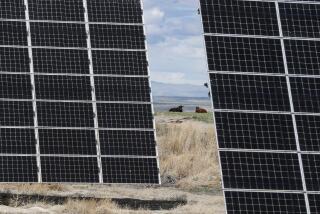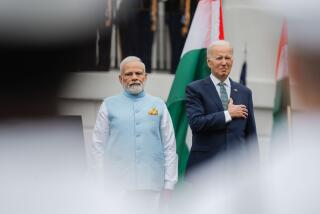Wind power takes its turn in new India
- Share via
sinban, india -- The wind farm is visible from miles away, a forest of looming turbines churning in the afternoon breeze, rising incongruously above fields of barley, corn and sunflowers.
“This is the only future for the long term,” says Tulsi Tanti, 49, a onetime yarn manufacturer who turned a small wind-energy sideline into the sprawling corporation Suzlon Energy, and turned himself into a billionaire in the process.
If wind power has a reputation for being on the fringes -- an expensive technology that has more to do with environmentalist dreams than electricity production -- India is proving it to be a viable energy source, even in the developing world. India has the fourth-highest installed capacity for wind power in the world, behind only Germany, Spain and the United States, according to the Global Wind Energy Council.
Wind, like solar and other renewable energy sources, still faces major hurdles. In India, it costs a wind farm about 7 U.S. cents to produce a kilowatt-hour of electricity -- approximately 50% more than coal, according to the New Delhi-based Energy and Resources Institute. As in most countries, wind energy in India is supported by tax breaks and subsidies that make it competitive.
Even Tanti acknowledges that wind isn’t going to replace coal -- which today supplies about 65% of India’s electricity -- anytime soon.
But the cost of wind has dropped dramatically in the last decade, in some cases by more than half, and is expected to drop further as the technology advances. And coal could become more expensive if global warming forces countries to adopt costly methods to reduce the pollution it generates.
About 2% of India’s power comes from wind but, as costs drop, that could reach 12%, experts say. “It’s a serious energy source, as far as India is concerned,” says Mahesh Vipradas, a fellow at the Energy and Resources Institute.
One thing is certain: India needs more energy. With 1.1 billion people and an economy growing at close to 9% per year, the country is fast becoming one of the world’s largest energy consumers.
Experts estimate that India has 10% to 12% less power than it needs. Blackouts are common, even in the largest cities, and hot summer nights can find millions of people sleeping on rooftops, praying for a breeze because their fans and air conditioning won’t go on.
“The whole world needs more and more energy, that is the topmost priority for any economic growth,” Tulsi says during an interview in the Suzlon office in Pune, a western Indian city. “Any one source -- or any two, three sources -- cannot satisfy this demand.”
That’s where wind comes in.
Three years ago, India had about 2,500 megawatts of wind capacity installed. Today, that has reached more than 7,000 megawatts -- enough to power about 30 million homes.
The Indian government has pushed the wind business with tax breaks on windmills, which can cost upward of $1.2 million apiece, and mandates that states get a percentage of their electricity from renewable sources.
All this has been a big boost to Suzlon, by far the biggest wind player in the country.
Tanti and his brothers founded the company in 1995, stumbling into the business after the local power grid couldn’t keep their textile factory going. They purchased a couple windmills and soon left textiles behind.
In recent years, the business has grown about 100% annually, swallowing up other companies and raking in profits. The company recently moved its global marketing headquarters to Denmark, but the Indian operations are still run from Pune.
Here, in the hills of eastern India, Suzlon operates one of the largest wind farms in the world: more than 500 windmills on 1,300 acres, sprawling across hills, villages and roads and generating more than 600 megawatts of electricity. The blades of the soaring white machines -- the tallest ones are about 245 feet high -- cast shadows that slash across the fields.
Suzlon operates, in many ways, as an energy “developer,” building windmills that are sold to investors or to companies that want to generate their own electricity. At this wind farm, the investors keep the earnings from electricity production while benefiting from generous tax-depreciation rules. Suzlon charges a fee to manage the operation.
Even in the shadow of this vast wind farm, built here to take advantage of regular winds, reliable electricity service remains rare.
India’s tortuously complicated energy laws restrict how electricity can be distributed. Nothing produced here can go directly to locals; it must be funneled through a state utility. Even at the wind farm’s offices, a generator is on standby.
“We get a few hours [of electricity] every day,” said villager Gokul Bhagwan Mali, sitting near the town center, no more than a tea stand with a small wooden bench. “But not enough to do very much.”
More to Read
Sign up for Essential California
The most important California stories and recommendations in your inbox every morning.
You may occasionally receive promotional content from the Los Angeles Times.













